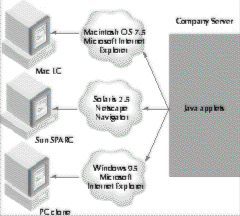
Java has been described as a “revolution” in business computing. This high-level programming language was developed by Sun Microsystems and was designed for handheld devices and set-top boxes. Java was originally called Oak. Because the Oak product never made it to market, in 1995 Sun changed course and went after the Internet, changing the product name to Java.
Java is a download-and-run model for the Internet.
Java is an object-oriented language similar to C++ but much simpler to work with. It was designed with the network environment in mind. According to Kim Polese, former Java product manager, Java’s unique network features include:
Java works differently than desktop software applications that are currently available. Java applications, or “applets,” are not necessarily stored on your PC. Instead, these small programs are usually stored on a central network server. Figure 2-8 shows how the Java applet works. When your browser encounters a Web page in which a Java applet is stored, the applet is downloaded (as requested by your browser). Since these applets are designed to be relatively small programs, they should load more quickly than larger applications do. Version control is made easier with the central storage model of Java applets.
You can run any application from a server to any computer with a Java Virtual Machine.
According to Java evangelists, one of the big perks for the IS professional is Java’s ability to both vastly simplify application creation and deployment while maintaining existing legacy computers and software. Once written, Java programs can run with-out modification on most computers with an Internet browser or on a Java Virtual Machine. The underlying operating system makes no difference to Java.
FIGURE 2-8
Java applets execute on devices that have Java Virtual Machines.
